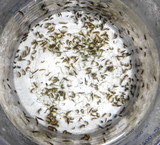Amphipods for sale are a great Live forage animal to introduce and establish in the reef tank aquarium.
Benefits when you buy amphipods as live fish food mandarin fish food and live food for seahorses from RUSALTY.com for your saltwater tank.
Our cultures of amphipods for sale at ANF are a hardy strain adapted through many generations to life in captivity. Grown in closed recirculating systems. Pathogen free.
When you seed amphipods in your saltwater aquarium tank and Refugium. Amphipods will reproduce readily in the home aquarium thus providing a highly nutritional source of live fish food for fish and invertebrates like mandarin dragonets, seahorses, pipefish, corals, and many others.
Eventually amphipods will establish a breeding colony and you will achieve a continuous supply of live pods off all sizes and stages of development for different sized fish to eat.
Amphipods are a great micro clean up crew, constantly eating fish waist and left over fish food.
Amphipods also eat nuisance algae to help keep your aquarium clean.
Amphipod body length varies from 1 to 140 mm (0.04 to 5.5 inches), but the amphipod of midlatitude regions is about 4 to 10 mm long (0.16 to 0.4 inch). Many amphipods are brightly coloured—red, pink, yellow, green, or blue. The body is usually compressed from side to side (i.e., height is greater than width), thus in part facilitations rapid sliding movement through algal fronds (leaflike structures). Most amphipods are active swimmers, being propelled by three pairs of abdominal appendages. That they are also strong jumpers is best seen in sand fleas.
The antennae are long and hairy. As in the shrimp, the head and tail ends are often curved downward. The eyes are sessile (without a stalk).
Amphipod species (such as those of the family Gamaridae) are mostly scavengers and herbivores that typically burrow into the soft mud of the sea bottom. Amphipod gills are partially protected by long coxae, which are ventral extensions of the basal leg segments. Amphipods have compound eyes, like crabs and insects; however, the eyes of amphipods never occur on stalks.
Amphipod sexes are separate, males often being characterized by enlarged gnathopods (claws on the second thoracic segment) used to grasp females during copulation. The male presumably emits sperm, or spermatophores (balls of sperm), to fertilize the eggs of the female externally.
The number of Amphipod eggs in a clutch varies from one to more than 250. The arrangement of gills provides a chamber for fertilized eggs, which are carried externally by the female and held in a cluster near the gills. The gammaridean egg cluster is probably oxygenated with water currents created by beating appendages called pleopods. Eggs hatch in 2 to 59 days, and the young may remain in the brood pouch for from 2 to 35 days. After six to nine molts over an interval of one to four months, sexual maturity is attained. A few cold-water species live at least a year, perhaps far longer.
Description
Amphipods are poor swimmers, being highly modified as bottom crawlers and scavenging macrophages (Russell-Hunter 1969). They lack a caprapace, have sessile eyes, the pleopods are respiratory in function, and the uropods do not form a tail fin (Russell-Hunter 1969). Amphipods typically are laterally flattened and normally have a division of functions among the varied limbs (Russell-Hunter 1969).
Amphipods have two characteristic body forms of amphipods are those of the Caprellidea and those of the Gammaridea. The gammarids, which include the beach-fleas, are compact, flattened from side to side, have three pairs of uropods (tail-limbs), the head has two pair of antennae, the eyes are not on stalks, and there are seven thoracic and six abdominal segments that are visible (MVA 1996). The long and skinny Caprellidea—such as the ghost Shrimp Caprella—have very elongated limbs and thoraxes with a reduced abdomen (Russell-Hunter 1969).
